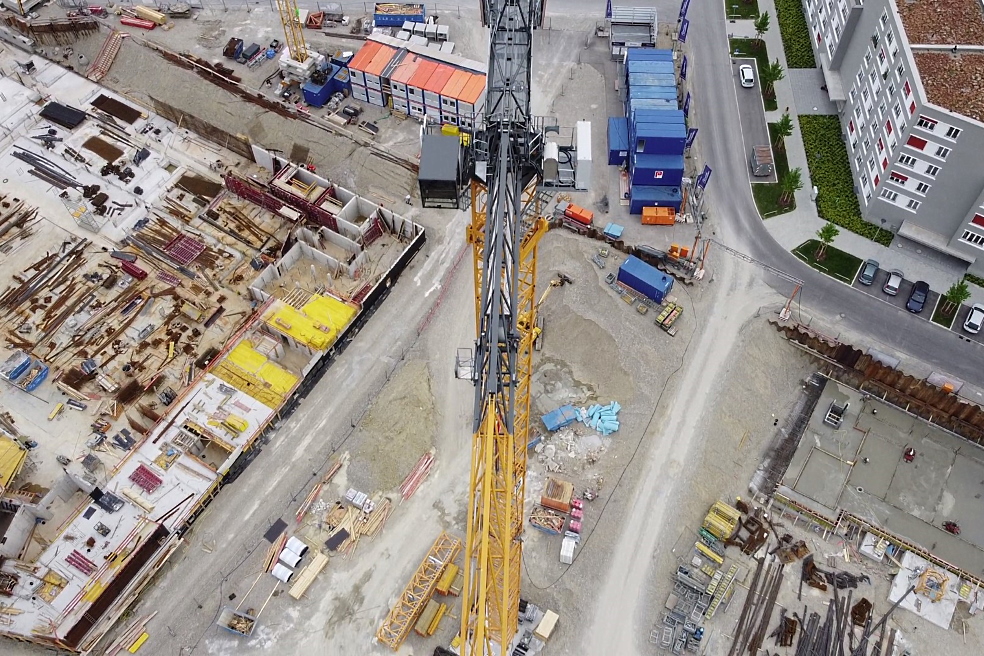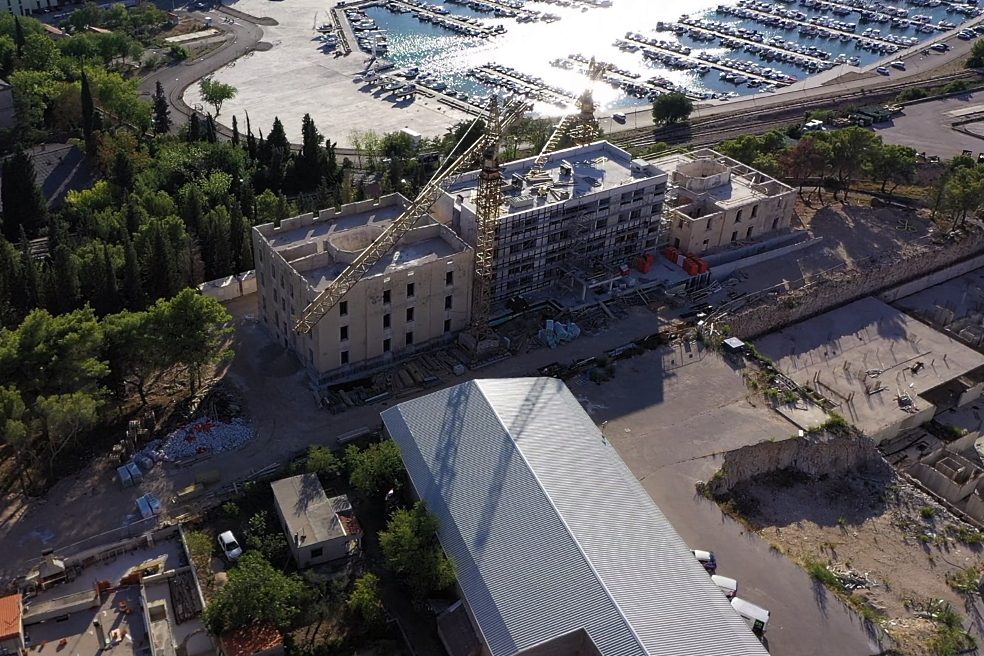Project finance and lending for the construction of commercial property
Sedona Investments offers:
• Investment financing from £5 - 500 million or more
• Minimizing the contribution of the project promoter
• Investment loan term up to 10 years
• Credit guarantees
Along with technological progress and the development of mobile technologies, the approach of business to the work environment is changing.
All of this affects the financing of capital-intensive projects and forces companies to rethink existing investments.
Despite the paradigm shift, office space will remain a place for meetings, presentations and so-called quiet workplaces. The new way of life is also making adjustments to the demand for shopping centers.
Today, more attention is paid to financing the construction of gastronomic and entertainment facilities.
The rapid growth of e-commerce will definitely limit the demand for other commercial properties, especially in retail.
Table: Opportunities and threats for commercial property construction projects.
| New opportunities | Potential threats |
| Increased investor interest in small towns, which are not yet saturated with modern commercial space. | Long-term economic challenges and the negative impact of the coronavirus crisis on the global market |
| The emergence of modern brands and the rapid development of large retail chains of a new format. | The complexity of financing new investment projects for the construction of commercial facilities |
| The emerging trend of economic recovery, bringing traditional spheres back to life. | Difficulties of small tenants who are forced to leave the market due to the transition to a new format |
Commercial properties can include offices, retail spaces, entertainment centers, as well as warehouses, logistics and distribution facilities.
These buildings are most often built in the centers of large cities or residential areas and have a high level of decoration.
Funding for the construction of a commercial property is mainly carried out through bank loans and free funds provided by project sponsors.
If a company decides to invest in a commercial property for rent (office building, store, shopping center or warehouse), it is always important to have a professional approach to the choice of partners and financing models.
Project finance for the construction of a commercial property is also widely used.
Such models are implemented through newly created special purpose vehicles (SPV / SPE) in the form of limited liability companies or joint stock companies.
These companies raise financing as a borrower and are fully responsible for the construction and commissioning of the facility, and sometimes are involved in its subsequent operation.
A well-thought-out business plan has always been a key condition for providing financing for commercial property projects. Banks and investors analyze investment projects very carefully, from the financial structure to the analysis of investment performance.
An investor who plans to build office buildings or shopping centers usually targets two types of profit. The first type is related to the rent, and the second is based on the increase in the value of the property. Before starting construction, a company should look for potential tenants in order to start earning immediately after commissioning.
The tenants of a commercial property are currently mainly large reliable companies.
Commercial real estate is often built for a specific tenant, which affects the choice of financing instruments.
Companies undertaking the construction of a commercial building must select a reliable general contractor capable of delivering the project efficiently and on schedule. SI is ready to help you with the selection of a responsible company for the construction of facilities of any complexity under an EPC contract.
It is important to understand that the early years of SPV operations are usually unprofitable.
The company incurs huge costs associated with the purchase of land, construction and loan servicing.
Positive cash flow comes at least in the second or third year of operation, when rental income is stable, debt service costs are decreasing, and profitability is increasing.
Research and statistics show that rental prices for commercial real estate in the developed countries of Europe and North America are growing. This can be explained by open borders and significant capital inflows, an attractive legal framework for business, political stability and favorable conditions for free market activity.
Shopping malls, restaurants, hotels, industrial buildings and innovative logistics centers can be great value propositions even in the post-covid era, when much of the business goes online. Our financial team is ready to develop a suitable financial model for your project, providing comprehensive support and advice on any issues.
Sedona Investments offers financing of commercial property projects in any country of the world, including long-term bank loans from £50 million GBP with a repayment period of up to 20 years.
We offer low interest rates and flexible repayment schedules.
Thanks to close cooperation with the world's leading banks, we are ready to provide you with financing for investment projects with initiator's own contribution of up to 10%.
Commercial property construction loan
Bank financing of commercial construction is most often carried out according to the project finance formula (PF).Most of these projects in Europe are implemented with the participation of banks in one form or another. The PF model is based on the future cash flows of the construction project (commercial property for rent) and not on the assets of the borrowing company provided as collateral.
Project finance can be used both for the construction of new commercial real estate and for refinancing existing projects.
This type of transaction is almost entirely based on cash flows from lessees who have already entered into agreements or will enter into the future.
The borrower is usually a Special Purpose Vehicle / Special Purpose Entity, which is created only for the construction and management of a specific project. This model excludes the use of the assets of the initiator company as collateral, and banks rely entirely on the future income and assets of the project company as a source of debt repayment.

The off-balance sheet nature of project finance is also beneficial for initiators, since the debt is concentrated on SPV and does not have any negative impact on the financial statements of the company, which stands at the origins of a particular investment project.
The experience of using PF in various sectors, including the oil and gas sector, renewable energy, infrastructure and environmental projects, demonstrates the great potential of this model for the implementation of large promising projects by firms with limited financial resources.
Choosing a bank to finance commercial construction
Before an investor goes to the bank to obtain a loan, he must answer whether the construction project meets the basic requirements of the bank:• Legal requirements. Orderly legal status of real estate and land. Availability or readiness to establish a special purpose vehicle. Availability of permits or compliance with formal requirements for obtaining a building permit.
• Technical requirements. Experts must provide a positive opinion on the technical feasibility of the project. A detailed architectural design is important in this context. In addition, the bank takes into account the company's experience in construction projects.
• Financial requirements. Lending institutions usually require a potential borrower to pay an appropriate share (usually 10-30% of the total investment costs), as well as guarantees of compliance with debt service standards (DSCR not lower than 120%).
• Marketing requirements. An additional argument for the allocation of borrowed funds is the positive result of market research, confirming the possibility of renting retail space, warehouses or office space within the framework of the project.
The choice of a bank for financing commercial construction must be comprehensively thought out and justified.
When deciding to cooperate with a bank, an investor should be aware that over the next few years he will be doomed to cooperate with a lender.
The wrong choice can negatively affect the implementation of the project and even lead to its failure with corresponding financial and reputational losses for the initiating company and its partners.
Given the time frame for the construction of large commercial facilities, an investor may face various market, macroeconomic, political, and legislative obstacles that can affect the project. The investor's task is not only to analyze the conditions offered by the bank, but also to assess its reliability.
Will the bank be able to provide support over a long financing period?
Is the bank ready to meet the client's needs?
Support should be understood as the readiness of the bank to conduct a constructive dialogue with the borrower, as well as responsibly respond to unforeseen circumstances. Unfortunately, many companies make the mistake of choosing a bank, basing their decision on the cost of financing without taking into account other factors, including the bank's reputation, experience in financing construction projects, etc.
One of the first steps in the decision-making process should be an introductory meeting with the bank. At such a meeting, managers can present a construction project, receive preliminary information and credit conditions. To meet with the people involved in the implementation of the project on the bank's side, the best solution would be to meet with representatives of the department directly involved in project finance.
Sedona Investments is absolutely open to its clients, so you can familiarize yourself with our guarantees and financing conditions from the very beginning.
We are ready to provide detailed information regarding obtaining a loan for the construction of commercial real estate, debt service, collateral, as well as discuss special conditions for your project.
What to look for when choosing a bank to finance commercial construction:
• Stability and predictability of the bank. For large projects, it is recommended to choose a fairly large bank from the top ten, with a good financial condition and a strong department for working with corporate clients.
• Market experience in financing investment projects, the number and size of completed projects. This information will allow assessing whether the bank has developed project appraisal standards, effective lending and management procedures. This reduces to zero the risk of not understanding the specifics of project financing by the bank's employees.
• Competence and professional experience of the person who will lead the project. The importance of this point in the long-term financing process cannot be overemphasized. The quality of cooperation with the bank as a whole will depend on cooperation with this person.
• Loan documentation. The scope of this documentation, regardless of the size of the project, is quite extensive and is usually outsourced to specialized law firms. The cost of such a service can reach tens of thousands of euros.
• Restrictions on decision-making by the board of the company. Understanding these boundaries allows for an assessment of management discretion (for example, dividend payments, changes in shareholder structure, scope of disclosure obligations, and so on).
As mentioned earlier, the cost of an investment project is directly related to the size and financial resources of the banks that must participate in its financing.
In other words, a large project requires contacting a bank with a sufficiently strong capital base.
In general, project finance is a specialized area that requires not only capital, but also a strong expert base in the form of special departments for financing investment projects. For small banks, the allocation of such human and financial resources under the PF is unprofitable.
On the other hand, small projects often do not fit into the strategy of large financial institutions, which usually conclude deals worth tens and hundreds of millions of euros. Therefore, large players are reluctant to lend to small construction projects, forcing the investor to wander in a circle.
Do you need a large bank loan for the construction of commercial properties in Europe, USA, UAE or other regions?
SI offers long-term funding, professional assistance and advice.
Access to bank loans
Some investors complain that banks are reluctant to issue commercial construction loans.The decision may be related to more than just the scale of the project. In this section, we will explain in detail what construction projects banks are willing to finance.

Banks are taking the following measures to reduce the risks of financing commercial construction:
• Reducing the loan term to the minimum acceptable for a specific project.
• Requirement for the borrower to maintain conservative LTV (below 80%) and DSCR (above 120%) ratios. Establishing a credit margin depending on the actual LTV and DSCR.
• Minimizing the use of balloon loans with large payments at the end of the repayment period.
• Cooperation with companies that have sufficient experience in a particular segment.
• Increase in the required share of the initiator's own funds in projects, which reduces LTV. This requirement for the initiator's own contribution applies, in particular, to hotel projects.
• Increasing the share of pre-let in large investment projects, where the bank finances the construction of commercial real estate for rent, such as offices and shopping centers.
• Refusal to finance commercial construction of a speculative nature, when the property is being built in places with insufficient demand.
• Requiring obligatory repurchase of derivative financial instruments by the borrower in order to minimize foreign exchange risk.
Summing up, we can highlight the projects that are desirable for banks in the current market.
The most important criterion in deciding whether to finance this type of project is the location of the property.
Finding a tenant for an office building located far from infrastructure is not easy. The attractiveness of the location is of key importance for the bank financing the project. If the property is rented out in advance, it will certainly generate cash flows to repay the loan.
The level of the borrower's own participation in the project is also very important, as well as the clearly understood acceptance of the investment by the market. The latter is determined by the pre-let or pre-sale level. The preliminary agreements show what the investor can achieve in the context of the rent. Often, even before the start of construction, a building can be rented out by 30-50%, and as investment progresses, this percentage increases.
It is important for banks to see the documents by which tenants agree to pay a fixed amount for five or more years.
However, it is common for clients to negotiate mitigating terms that allow them to terminate the agreement early (for example, if the business is not meeting expectations).
As the number of such clauses in agreements increases, banks increase the initiator's own contribution. Obviously, this can be attributed to the increasing risk of the construction project. It also takes into account the professional experience and previous achievements of the project initiator.
It is much easier to get a loan for companies that can confirm their success and a good history of cooperation with financial institutions.
Banks check the financial health of the investor. Will he be able to support the project with his own funds if, for example, there are delays in construction or actual rental rates are lower than expected?
A potential borrower should be prepared for such questions.
Banks are also cautious when cooperating with new borrowers, especially if their market sub-segment has appeared recently and has not yet proven its stability and investment reliability. However, it is much easier for old clients and established sectors to obtain financing.
Real estate appraisal is important for access to the loan.
Banks pay attention to the quality of architecture, innovative design and ease of adaptation of premises to customer needs.
Alternative ways to finance commercial property projects
The most popular methods of financing commercial property projects are still traditional banking instruments.They account for more than half of all commercial construction debt financing in developed countries, according to a Cushman & Wakefield report.
Almost all large banks offer loans for the construction and acquisition of such objects, however, in order to approve the application, a potential borrower needs serious preparation. A good business plan is the key to success because banks analyze their clients' projects and strategies in detail.
Most often, banks finance construction projects with relatively high traffic or attractively located warehouse centers, for example, office buildings in the city centers and promising shopping malls.

Loans are usually provided in several currencies to choose from (euros or dollars) for up to 15-20 years. Commercial banks are flexible enough to adapt repayment schedules and other terms of the loan agreement to the needs of the borrowing company and the current situation in the sector.
In the case of obtaining a loan for the construction of a commercial property, payment can be made in accordance with the progress of work controlled by the inspector.
This can be done monthly and quarterly, and usually loan agreements allow for early repayment.
The loan can be repaid by selling the property or refinancing with an investment loan.
Despite the broad opportunities for bank lending, companies today are more likely to use alternative sources to finance large projects. Private investor groups are looking for reliable investment opportunities and offering their services. Acting on their own, these players do not have the opportunity to deal with issues that require wider financial participation, so the closed-end fund formula is a profitable and safe solution.
Recently, many American and Chinese funds have appeared on European markets, which aggressively begin to buy and finance local companies, mainly industrial companies. This is an interesting alternative for companies requiring costly loan restructuring. In this case, the bank usually does not become a participant in the investment project, but these are necessary and profitable mechanisms in the long term.
The growing interest in alternative sources of financing for commercial property projects is gradually making them more affordable for a wide range of entrepreneurs.
This is great news for companies that cannot get a large bank loan on adequate terms.
Competition is intensifying, so lenders can be expected to seek investment opportunities and engage in more complex construction projects that require significant funds and expertise.
Despite a certain slowdown in the sector associated with the pandemic, the market is changing dynamically, and this is the ideal time for an experienced player who can make quick financial decisions.
Leasing is becoming an increasingly popular form of financing, although it has serious limitations. In the case of commercial real estate, the essence of leasing does not differ from other forms. One of the companies acquires the facility (the lessor) and then transfers it to another company for use.
The lessee pays the lease payments to the lessor, and at the end of the contract, he can buy out the property. In the case of commercial real estate, the object can be, for example, whole buildings, but also separate areas. This is a relatively easily accessible and flexible form of financing, but lessors may have a number of stringent requirements. They usually only contract for commercially attractive buildings (office buildings, hotels, logistics centers, and the like).
Bonds have also become a popular source of funding.
Municipal bonds are issued in some national markets and are used for infrastructure investments.
Corporate bonds are also an interesting and increasingly popular form of raising capital.
The benefits of such a solution include, among other things, maintaining full control over the company (bondholders do not influence decision-making) and the possibility of improving the business structure (achieving an appropriate balance between equity and debt). Flexibility, fast processing and low cost of this financing method are also important.
The disadvantages of corporate bonds include a limited scope.
They are mainly suitable for companies in very good financial health. Weaker companies can also issue bonds, but given the risk, they should offer investors more attractive bonuses.
In addition, corporate bonds usually increase financial risk and worsen a company's liquidity. These restrictions require careful analysis of financial indicators and forecasts before the issue.
If you need financing for commercial real estate projects, contact the Sedona Investments specialists at any time.
We will be happy to contribute to your project.



